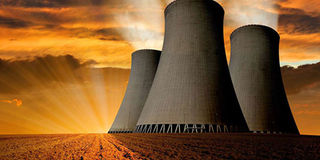Think nuclear addition to energy mix

A nuclear power plant. Because many people have no idea about the operations and benefits of nuclear energy, the packaging of the message is critical. PHOTO | FILE | NATION MEDIA GROUP
What you need to know:
- Besides appropriate legal and regulatory infrastructure, proper training of human resources is key to ensuring safety culture at all times.
- Nuclear energy being the cheapest source of power, we may ignite a torch of hope for our economy, and our future.
Some environmental enthusiasts opine that green energy sources are the only key to our energy prospects.
But this is only partly true as it is solely dependent on our objective for power consumption.
In case our focus is on lighting solutions, running computers, televisions and radios, then green sources are adequate.
But in case we need power to drive our industrialisation dream, it is evident that no country ever developed based on wind, solar and hydropower alone.
As Kenya aspires to be a medium-income economy and industrialised nation, energy is, inherently, an undisputed enabler for such economic growth.
Nuclear power is a clean, low-carbon energy source with insignificant emissions and is reliable, sustainable and competitively priced.
Besides, it can be used peacefully in the health sector for radiotherapy and sterilisation of medical supplies, desalination of seawater, conservation of food, pest control and conducting non-destructive tests.
RELIABLE SUPPLY
An interesting usage is by archaeologists, anthropologists and geologists in determining the ages of insects, and rocks, among others.
Kenya’s major energy mix includes hydro energy, geothermal, solar and fossil fuel plants.
Hydro energy forms 30 per cent generation and cannot sustain industrialisation alone, partly due to the impact of unreliable weather.
Geothermal energy contributes about half of our energy mix and is our base energy source. Solar makes up only 10 per cent. The 10 per cent balance is done by fossil fuel thermal plants.
We have almost exploited our geothermal sources and, by the time of its full exploitation, nuclear may be the only potential base source of power.
Solar and wind are intermittent sources that are not reliable for industrialisation.
Kenya’s nuclear journey should, inherently, involve training and setting up of legal and regulatory structures.
POLITICAL WILL
Also, the decision to go nuclear requires long-term commitments in terms of sociopolitical, legal and economic fronts.
Without a strong and stable political system, the project could turn out a white elephant.
We also have to work very closely with countries that have operated nuclear plants for decades and also develop strong ties with the International Atomic Energy Agency (IAEA) for lessons and to have stable guiding frameworks for issues such as disposal of low-, intermediate-, high- and very high-level waste.
Besides appropriate legal and regulatory infrastructure, proper training of human resources is key to ensuring safety culture at all times.
There is also a need to set up educational infrastructure to ensure sustainability of the long-term nuclear plan. Perhaps we should introduce nuclear-related studies right from primary school.
SET PROPER FOUNDATION
A sound regulatory infrastructure enhances public confidence on security of nuclear power plants.
Public acceptance is very important to avoid fear. Being a newcomer country, we must work very closely with the IAEA to ensure that all the 19 infrastructural issues that forms basis for nuclear standards are all adequately addressed before embarking on the nuclear power plant installation.
To speed up our nuclear energy prospects, Kenya needs to get a regulator whose mandate would include, but is not limited to, site characterisation and technology assessment.
Because many people have no idea about the operations and benefits of nuclear energy, the packaging of the message is critical.
For instance, in addition to power production, about 5,000 direct jobs may be attributable to a single 1,800MW power plant.
The neighbourhood of the plant may enjoy lower energy tariffs and other financial and infrastructural benefits.
Also, the plant can boost the government’s financial coffers in terms of increased tax avenues.
REAWAKEN ECONOMY
From a macroeconomic performance perspective, Kenya’s real gross domestic product (GDP) has been growing since 2017.
There is a correlation between GDP and per capita consumption of energy. Developed countries have high per capita consumption of energy and, for us to become a middle-income economy, we must be producing and consuming energy of reasonable proportions.
All the ‘Big Four Agenda’ pillars of manufacturing, affordable housing, universal health coverage and food and nutrition rely directly or indirectly on energy.
Factories, homes and medical equipment all require power while rain-fed agriculture is unsustainable.
Nuclear energy being the cheapest source of power, we may ignite a torch of hope for our economy, and our future.
We can then sustain heavy industries and light rail transportation besides domestic consumers paying less for their consumption.
Mr Maklago is a nuclear power plant engineering postgraduate student at KEPCO International Nuclear Graduate School, South Korea. [email protected]




